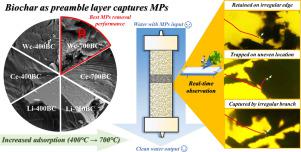Water Research ( IF 11.4 ) Pub Date : 2022-06-19 , DOI: 10.1016/j.watres.2022.118783 Lichun Hsieh 1 , Lei He 1 , Mengya Zhang 1 , Wanze Lv 2 , Kun Yang 2 , Meiping Tong 1

|
The release of microplastics (MPs) especially those with sizes less than 10 μm from effluent of wastewater treatment plants (WWTPs) is one of the major sources of plastics into aquatic environment. To reduce the discharge of MPs into environment, it is essential to further enhance their removal efficiencies in WWTPs. In present study, to boost the removal performance of MPs in sand filtration systems (units that commonly employed in WWTPs to remove colloidal pollutants), six types of biochar fabricated from three raw biomass materials (i.e. lignin, cellulose, and woodchips) at two pyrolysis temperatures (400 °C and 700 °C) was respectively amended into sand columns as thin permeable layer. We found that adding all six types of biochar into sand columns as thin permeable layer could greatly improve the retention of MPs with the diameter of 1 μm under either slow (4 m/d) or fast flow rates (160 m/d) due to the high adsorption capability of biochar. Woodchip-derived biochar exhibited the highest MPs retention performance, which was followed by cellulose-derived biochar and then lignin-derived biochar. Moreover, for biochar derived from three raw biomasses, increasing pyrolysis temperature could improve MPs retention performance. The direct observation of real-time plastics retention processes on different types of biochar via a visible flow chamber showed that woodchip-derived biochar especially that fabricated at 700 °C exhibited more MPs trapping processes relative to lignin and cellulose-derived biochar due to their more complex surface morphology. Thus, the highest MPs retention performance was achieved in sand columns with amendment by 1 wt% woodchip-derived biochar fabricated at 700 °C. More importantly, we found that for these modified sand filtration column systems, complete MPs removal could be achieved in real river water and actual sewage water, in multiple filtration cycles, longtime filtration process (100 pore volumes injection) as well as with interval flow conditions. Moreover, biochar could be regenerated and reused as thin permeable layer to effectively remove MPs. The results of this study clearly showed that biochar especially woodchip-derived biochar fabricated at 700 °C had the potential to immobilize MPs especially those with small sizes in WWTPs.
中文翻译:

将生物炭作为薄前导层添加到砂滤柱中可以改善水中微塑料的去除
微塑料 (MPs) 的释放,尤其是那些从污水处理厂 (WWTPs) 流出物中尺寸小于 10 μm 的微塑料,是塑料进入水环境的主要来源之一。为了减少 MPs 排放到环境中,有必要进一步提高它们在 WWTPs 中的去除效率。在目前的研究中,为了提高 MPs 在砂滤系统(污水处理厂中常用的去除胶体污染物的单元)中的去除性能,由三种生物质原料(即木质素、纤维素和木片)在两次热解中制成的六种类型的生物炭温度(400°C 和 700°C)分别修正为砂柱作为薄渗透层。我们发现,将所有六种类型的生物炭作为薄渗透层添加到沙柱中,可以大大提高直径为 1 μm 的 MP 在慢流速(4 m/d)或快流速(160 m/d)下的保留,因为生物炭的高吸附能力。木片衍生的生物炭表现出最高的 MPs 保留性能,其次是纤维素衍生的生物炭,然后是木质素衍生的生物炭。此外,对于来自三种生物质的生物炭,提高热解温度可以提高 MPs 的保留性能。通过可见流动室对不同类型生物炭的实时塑料保留过程的直接观察表明,木片衍生的生物炭,尤其是在 700 °C 下制造的生物炭,相对于木质素和纤维素衍生的生物炭表现出更多的 MPs 捕获过程,因为它们更多复杂的表面形态。因此,在 700 °C 制备的 1 wt% 木片衍生生物炭的修正砂柱中实现了最高的 MPs 保留性能。更重要的是,我们发现对于这些改进的砂滤柱系统,在实际河水和实际污水中,在多个过滤周期、长时间过滤过程(100 孔体积注入)以及间隔流动条件下,都可以完全去除 MPs . 而且,biochar 可以再生并作为薄渗透层重复使用,以有效去除 MPs。这项研究的结果清楚地表明,生物炭,尤其是在 700 °C 下制造的木片衍生的生物炭具有固定 MPs 的潜力,尤其是那些在 WWTP 中尺寸较小的 MPs。









































 京公网安备 11010802027423号
京公网安备 11010802027423号